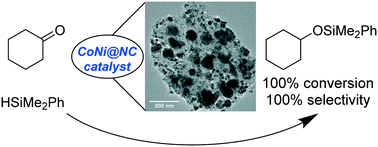当前位置:
X-MOL 学术
›
Catal. Sci. Technol.
›
论文详情
Our official English website, www.x-mol.net, welcomes your
feedback! (Note: you will need to create a separate account there.)
Cobalt–nickel alloy catalysts for hydrosilylation of ketones synthesized by utilizing metal–organic framework as template†
Catalysis Science & Technology ( IF 4.4 ) Pub Date : 2018-04-12 00:00:00 , DOI: 10.1039/c8cy00150b Niklas R. Bennedsen 1, 2, 3, 4 , Søren Kramer 1, 2, 3, 4 , Jerrik J. Mielby 1, 2, 3, 4 , Søren Kegnæs 1, 2, 3, 4
Catalysis Science & Technology ( IF 4.4 ) Pub Date : 2018-04-12 00:00:00 , DOI: 10.1039/c8cy00150b Niklas R. Bennedsen 1, 2, 3, 4 , Søren Kramer 1, 2, 3, 4 , Jerrik J. Mielby 1, 2, 3, 4 , Søren Kegnæs 1, 2, 3, 4
Affiliation

|
In this article, we report an approach to synthesize alloy Co–Ni nanoparticles encapsulated in carbon by utilization of the MOF, ZIF-67, as a sacrificial template. The alloy CoNi materials are synthesized by incipient wetness impregnation of cobalt-containing ZIF-67 with nickel(II) nitrate followed by carbonization. The formation of alloy nanoparticles was verified by XRD and TEM analysis showed that they are distributed evenly throughout the entire material. The carbon encapsulating the alloy nanoparticles is N-doped and graphitic according to XPS analysis. Further characterization by ICP, N2-physisorption, and SEM imaging was also performed. The CoNi materials exhibited promising activity in the catalytic hydrosilylation of ketones. A carbonization temperature of 800 °C provided the best catalyst for this transformation. The reaction conditions were optimized, different silanes tested, a time study conducted, and the heterogeneity of the catalysis assessed with different tests. Finally, a substrate scope of various ketones was examined.
中文翻译:

钴-镍合金催化剂用于通过利用金属有机骨架作为模板合成酮的氢化硅烷化†
在本文中,我们报告了一种利用MOF ZIF-67作为牺牲模板来合成封装在碳中的Co-Ni合金纳米颗粒的方法。CoNi合金材料的合成方法是先用硝酸镍(II)湿浸含钴的ZIF-67,然后进行碳化。XRD和TEM分析证实了合金纳米颗粒的形成,表明它们均匀地分布在整个材料中。根据XPS分析,包封合金纳米颗粒的碳是N掺杂的和石墨的。通过ICP进一步表征N 2-物理吸附,并进行SEM成像。CoNi材料在酮的催化氢化硅烷化中显示出有希望的活性。800℃的碳化温度为该转化提供了最佳催化剂。优化反应条件,测试不同的硅烷,进行时间研究,并通过不同的测试评估催化的非均质性。最后,检查了各种酮的底物范围。
更新日期:2018-04-12
中文翻译:

钴-镍合金催化剂用于通过利用金属有机骨架作为模板合成酮的氢化硅烷化†
在本文中,我们报告了一种利用MOF ZIF-67作为牺牲模板来合成封装在碳中的Co-Ni合金纳米颗粒的方法。CoNi合金材料的合成方法是先用硝酸镍(II)湿浸含钴的ZIF-67,然后进行碳化。XRD和TEM分析证实了合金纳米颗粒的形成,表明它们均匀地分布在整个材料中。根据XPS分析,包封合金纳米颗粒的碳是N掺杂的和石墨的。通过ICP进一步表征N 2-物理吸附,并进行SEM成像。CoNi材料在酮的催化氢化硅烷化中显示出有希望的活性。800℃的碳化温度为该转化提供了最佳催化剂。优化反应条件,测试不同的硅烷,进行时间研究,并通过不同的测试评估催化的非均质性。最后,检查了各种酮的底物范围。











































 京公网安备 11010802027423号
京公网安备 11010802027423号